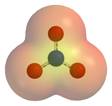 Nitrate Measurements Nitrate Measurements
|
How Can We Measure Nitrates?
Some chemicals change visibly in the presence of nitrate ions. Scientists have made an indicator that helps them determine the concentration nirtrate ions in various solutions.
The nitrate strips arecoated with several chemicals that, through a series of reactions, produce a color change proportional to the concentration of nitrate ions. In a high concentration, the strip turns bright violet-red. At low concentrations, it is only a faint pink. |
Units and Standardization
Nitrates are measured in units of concentration, which are the number of nitrate molecules in a given volume of water. Typical concentrations are usually betweem 10 and 500 parts per million (ppm). |
Materials
protective gloves
protective goggles
sample
clean, clear high-density polyethylene (HDPE -#2 plastic) or glass jar
TERC water pump (for samples from depth)
nitrate strips
|
Procedure: Nitrate strips
1 Put on protective gloves and goggles.
2 Collect a sample into a clean, clear high-density polyethylene (HDPE - #2 plastic) or glass jar, using either the TERC water pump (for samples from depth) or the sample collection method described below (for surface samples).
3 Carefully remove a nitrate strip from the package, holding it with the arrows pointing away from you.
4 Place the nitrate strip in the water sample for 10 seconds.
5 Remove the strip from the water sample. Let the color develop for 30 seconds, and then compare the indicator pad with the color chart to obtain a measurement of nitrates in mg/L.
(To test vegetables, grind them until they form a mush, capturing any liquid. Ideally the liquid would be captured in a test tube and stored in a refrigerator. When ready to test, bring up to room temperature. Dip the end in for 10 seconds. |
 If your reading is too high: Dilution If your reading is too high: Dilution
If your reading is so red it is beyond the most intense color on the color chart, you will need to dilute the sample and multiply the results times your dilution factor.
1. Dilute the liquid 1 to 10. Measure 1 ml of the liquid and fill a gradulated cylinder to the 10 ml mark with water. Test this solution again, and compare the results with the color chart. If it is still "upscale," dilute it by 1/10 again. continue the pocess until you obtain a reading that is on the color chart.
Multiple the reading from the color chart by the dilution factor (1/10 or 1/100 0r 1/1000...) |
 If your reading is too low: Evaporation If your reading is too low: Evaporation
If your reading is less than 10 mg/L, bring a sample to the lab and measure the nitrate level using the following evaporation technique:
1. Fill a clean ovenproof glass granulated container with 40 mL of the water sample.
2. Heat the container in the oven or on a heating pad until 20 mL has evaporated and 20 mL of the sample are left.
3. Measure the nitrate level of the new sample.
The sample is now twice as concentrated as the original sample (because the water evaporated but the nitrates stayed behind).
This will make the nitrate level measurable, but your actual nitrate level is half your final reading.
If you still have a reading of less than 10 mg/L, repeat heating the sample until only 10 mL are left. This sample is now four times more concentrated than the original, so the actual nitrate level is one-fourth of your final reading. You can repeat this process as necessary. |
Back to Water Index
Water Dissolves Index |
 Nitrate Measurements
Nitrate Measurements If your reading is too high: Dilution
If your reading is too high: Dilution